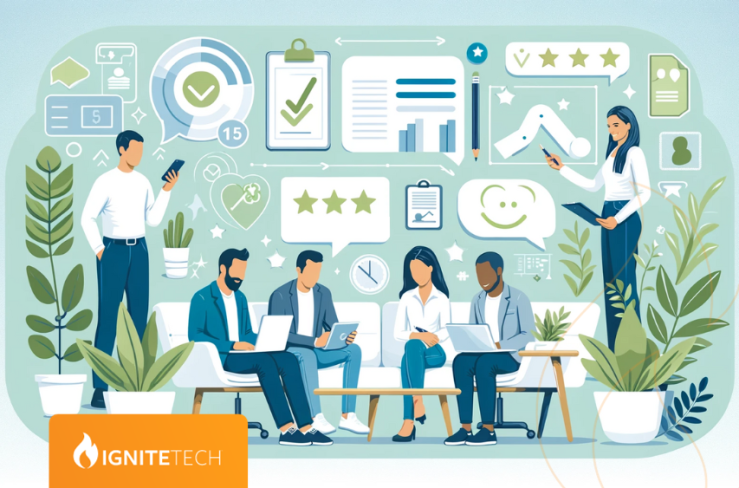Creating a customer-centric culture is essential for business success. With 66% of customers expecting companies to understand their needs, prioritizing customer experience is no longer optional. In a market where customer satisfaction is critical to profitability, and businesses in the US lose approximately $35 billion annually due to poor customer experiences, the importance of a customer-centric approach should not be underestimated.
Understanding and prioritizing customer needs
A deep understanding of customer needs and desires is fundamental. A CallMiner report reveals that 86% of customers would leave a brand after two poor experiences. To build a customer-centric culture, companies must start by thoroughly understanding their customer’s needs, desires, and expectations. This involves an in-depth analysis of customer feedback, purchasing patterns, and engagement metrics. The goal is to frame products, services, and marketing campaigns to meet these needs.
This underscores the importance of tools like CoreTrac CRM, which helps businesses gather and analyze customer data, tailoring services and products to meet and exceed customer expectations.
Customer interactions form the cornerstone of building strong relationships. Each interaction is an opportunity to understand and respond to customer needs. Advanced CRM systems improve these interactions by providing detailed customer histories, enabling personalized communication, which is key to reducing customer churn, which has increased significantly in recent years.
Democratizing customer insights across the organization
A critical aspect of customer-centricity is making customer insights accessible to every team member. When customer data is available across departments, it empowers employees to make decisions that are aligned with customer needs. Tools like Kayako can centralize customer feedback and inquiries, providing a single source of truth about customer preferences and issues. This centralization ensures that every department from marketing to product development is working with the same understanding of the customer, leading to more unified and effective customer-focused strategies.
Aligning Organizational KPIs with Customer Outcomes
To ensure a truly customer-centric approach, it’s vital to align key performance indicators (KPIs) across the organization with customer satisfaction and loyalty metrics. This alignment can transform the way departments operate, making customer satisfaction a shared goal rather than the responsibility of a single team. Analytical tools like BryterCX can help track and integrate customer-centric KPIs such as Net Promoter Score and Customer Lifetime Value into the broader business strategy. This alignment is essential as customer-centric companies are 60% more profitable than those that aren’t.
Using Customer Insights to Influence Business Decisions
In a customer-centric culture, customer insights drive business decisions. This means using data-driven insights to guide everything from product development to customer service strategies. CRM solutions like CoreTrac provide a wealth of data that can inform product improvements, marketing campaigns, and customer service enhancements.
By leveraging these insights, businesses can tailor their products and services to better meet customer expectations. This could involve customizing the features of a product, adjusting service protocols, or even developing entirely new offerings based on identified customer needs. Additionally, marketing campaigns can be more effectively targeted, resonating more deeply with customers because they are based on real insights into what customers find appealing and relevant.
Furthermore, using customer insights in decision-making helps businesses stay agile and responsive to changing market conditions and customer preferences. For example, insights gathered from CRM data can help businesses rapidly pivot their strategies in response to emerging trends or feedback, ensuring they remain relevant and customer-focused.
Customer insights also enable businesses to personalize their interactions with customers, creating a more engaging and satisfying experience. Personalization, based on a deep understanding of individual customer preferences and behaviors, can lead to increased customer loyalty and advocacy. This could manifest in personalized communication, tailored offers, or customized product recommendations, all aimed at providing a unique and memorable customer experience.
Inclusive Training and Resource Provision for a Customer-Centric Approach
Adopting a customer-centric culture demands a holistic transformation across the entire organization. This transformation requires a fundamental shift in mindset and operations, where every employee understands and values the importance of the customer experience.
To facilitate this shift, comprehensive training programs are essential. These programs should focus on educating employees about the principles of customer-centricity, including understanding customer needs, enhancing customer interactions, and the importance of customer feedback in shaping business decisions. Training should also encompass practical aspects, such as how to effectively use customer data to make informed decisions and how to personalize customer interactions.
Moreover, employees should be equipped with the necessary resources to understand the customer journey in its entirety. This includes access to detailed customer profiles, historical interactions, feedback, and preferences. Tools like SupportSoft CoPilot are invaluable in this regard. They provide employees with a platform to access and analyze customer information, thereby enhancing their understanding of customer needs and expectations. With such insights at their fingertips, employees can make more informed, customer-focused decisions.
Finally, continuous learning and adaptation are key components of a customer-centric culture. Customer needs and preferences evolve, and so should the organization’s approach to meeting these needs. Regular training updates, workshops, and seminars can help keep employees abreast of the latest trends and best practices in customer service and experience.
Long-Term Commitment to Customer-Centric Practices
Building and maintaining a customer-centric culture requires a long-term commitment. It involves continuous evaluation of customer needs, adapting strategies to meet these evolving needs, and consistently measuring the impact of various initiatives on customer satisfaction. Regularly revisiting and refining customer-centric strategies is key to staying relevant and competitive in a market driven by customer preferences.
A strong customer culture is the backbone of a successful business in today’s market. IgniteTech’s solutions like CoreTrac CRM, Kayako, and BryterCX provide the necessary tools to build, implement, and sustain a customer-centric culture, ensuring businesses meet and exceed customer expectations, fostering loyalty, and driving growth.






